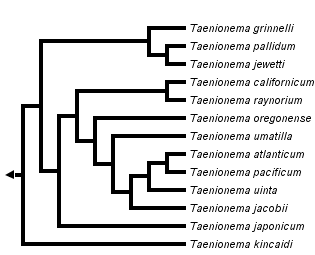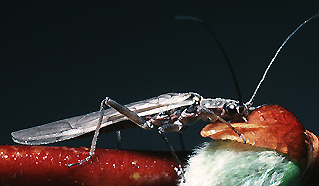Taenionema
C. Riley Nelson


This tree diagram shows the relationships between several groups of organisms.
The root of the current tree connects the organisms featured in this tree to their containing group and the rest of the Tree of Life. The basal branching point in the tree represents the ancestor of the other groups in the tree. This ancestor diversified over time into several descendent subgroups, which are represented as internal nodes and terminal taxa to the right.

You can click on the root to travel down the Tree of Life all the way to the root of all Life, and you can click on the names of descendent subgroups to travel up the Tree of Life all the way to individual species.
For more information on ToL tree formatting, please see Interpreting the Tree or Classification. To learn more about phylogenetic trees, please visit our Phylogenetic Biology pages.
close boxIntroduction
Thirteen species of Taenionema are currently recognized (Stanger & Baumann 1993). Most are found in western North America with a single species in eastern North America and another single species found in Japan and eastern Asia.
Characteristics
Stanger and Baumann (1993) used the suggestions of Ricker and Ross (1975) to list the synapomorphies of the genus as: 1. The epiproct is narrow with the tip bent back or otherwise modified. The tip is sharply pointed from a lateral aspect and slightly scooped out behind. 2. The basicercal processes are rounded, elongate, either fleshy or narrow, and are directed mostly dorsaly with the tip narrowed and curved back. 3. The posterolateral corners of sternum 9 in the male are slightly to moderately elevated, with the middle region of the hind margin of the sternum depressed. Stanger and Baumann (1993) produced the matrix for the species in the genus along with the tree that is used on this page.
References
Ricker, W. E. and H. H. Ross. 1975. Synopsis of the Brachypterinae (Insecta: Plecoptera: Taeniopterygidae). Canad. J. Zool. 53: 132-153.
Stanger, J. A. and R. W. Baumann. 1993. A revision of the stonefly genus Taenionema (Plecoptera: Taeniopterygidae). Trans. Amer. Entomol. Soc. 119: 171-229.
About This Page
C. Riley Nelson

Brigham Young University, Provo, Utah, USA
Page copyright © 1996
All Rights Reserved.
Citing this page:
Nelson, C. Riley. 1996. Taenionema. Version 01 January 1996 (under construction). http://tolweb.org/Taenionema/14392/1996.01.01 in The Tree of Life Web Project, http://tolweb.org/








 Go to quick links
Go to quick search
Go to navigation for this section of the ToL site
Go to detailed links for the ToL site
Go to quick links
Go to quick search
Go to navigation for this section of the ToL site
Go to detailed links for the ToL site